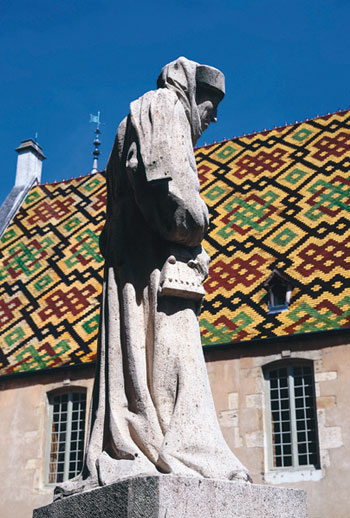Hospices de Beaune: a humanistic and architectural masterpiece in Burgundy
 In 1443, just as the Hundred Year's War was ending, Nicolas Rolin, Chancellor of Philip the Good, Duke of Burgundy, and Rolin's wife, Guigone de Salins, decided to build a hospital to take care of the needs of the sick and destitute.
In 1443, just as the Hundred Year's War was ending, Nicolas Rolin, Chancellor of Philip the Good, Duke of Burgundy, and Rolin's wife, Guigone de Salins, decided to build a hospital to take care of the needs of the sick and destitute.


 Nicolas Rolin explained that all was cared for in the hospice, saying that the poor patients of the time, "are welcomed, fed and cared for, at the hospital's cost, until they have returned to good health or convalescence."
Nicolas Rolin explained that all was cared for in the hospice, saying that the poor patients of the time, "are welcomed, fed and cared for, at the hospital's cost, until they have returned to good health or convalescence."
The city of Beaune was chosen, as it was a city much visited, but with no hospital. L'Hôtel-Dieu des Hospices de Beaune was founded on August 4th, 1443. Nine years of construction work were needed before the hospital could receive its first patient on January 1, 1452.
In 1459, Nicolas Rolin was able to organize the foundation of the community of care-giving sisters who ran l’Hôtel-Dieu de Beaune, sisters whose vows and rules included both a religious life and taking care of the ill.
The work of Nicolas Rolin and his wife were to be exceptional. The building involved the participation of many artists, as well as the local townspeople. The result is a masterpiece of medieval architecture.
The edifices, built around a central courtyard, offer a stunning visual contrast, with a rather austere, exterior facade, quite different from what the viewer discovers inside. The roofs, are composed of shiny varnished tiles in shades of brown, yellow, green and red, forming geometric patterns, in a traditional Burgundy architectural style, developed in the beginning of the fourteenth century. Visiting this courtyard, you'll marvel at the column galleries, in stone on the ground floor and in timber framework on upper level, both looking onto the courtyard, and which once allowed the care-giver sisters to circumvent the courtyard, remaining sheltered from rain, snow, sun and wind.
The Salle des "Pôvres" (Room of the Poor) of imposing dimensions, is covered by a paneled vault arch, containing sculpted monsters in its curves. This vast room contains 28 beds, each draped in red and facing the chapel, so that the patients could follow the religious ceremonies while kept warmly tucked in bed. The numerous rooms of this hospice are each named after a different Catholic saint. While exploring them, the visitor can contemplate countless treasures: paintings, sculptures, brightly colored tapestries, period utensils, furniture, beds, chests and cabinets. More than 5,000 object from the collection can be found here. Certain objects come from the hospital at its origins, or from later purchases by the hospital. Others were donated by benefactors or patients. The most renowned work at les Hospices de Beaune is, without at doubt, the polyptych of The Last Judgement by Roger van der Weydenis.
The Salle Saint-Louis, was a room where patients were welcomed. Today, in this room, we can find a selection of tapestries and furnishings from the Hospice collection. The altarpiece can be viewed in a specially reserved room, just adjoining the Salle Saint-Louis.
A monument full of history and meaning, Les Hospices de Beaune is a place of discovery and of memory, residing in the heart of Burgundy.
Photos © Hospices de Beaune
Luxury hotels and designer Bed and Breakfasts in Burgundy, Business hotels and Secret places, Unusual hotels and B&B










